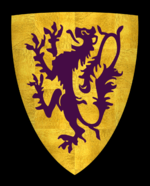

 Walter de Lacy, Lord of Weobley
Walter de Lacy, Lord of Weobley 


General Notes
Accoridnig to Wikipedia - see https://en.wikipedia.org/wiki/De_Lacy
Brothers Ilbert and Walter jointly held the Norman lands that were held of the Bishop of Bayeux. They participated in the Norman conquest of England. While there is evidence that Ilbert fought at William's side at Hastings, there is no record of Walter fighting at Hastings. Ilbert was a major participant in the Harrying of the North (1069–70) which effectively ended the quasi-independence of the region through large-scale destruction that resulted in the relative "pacification" of the local population and the replacement of local Anglo-Danish lords with Normans. In return, he received vast grants of land in West Yorkshire, where he built Pontefract Castle.
The southern branch of Marcher Lords, centred on Herefordshire and Shropshire, was held by Walter's descendants.
This southern branch of the family became substantial landholders in the Lordship of Ireland and was linked to the Scottish royal family; Elizabeth de Burgh, great granddaughter of Walter de Lacy, married Robert the Bruce, King of Scotland.
Walter de Lacy, the son of Hugh de Lacy, Lord of Lassy, was granted the lordship of Weobley in Herefordshire after the Conquest. He is already attested in the Welsh Marches by 1069. By the time of Walter's death, he held blocks of land in Herefordshire (including Holme Lacy) along the border with Wales with another group of lands centered on Ludlow in Shropshire. These groupings allowed Walter to help defend the England–Wales border against Welsh raids. He also had smaller holdings in Berkshire, Gloucestershire, Worcestershire and Oxfordshire. Walter was second in the region only to William FitzOsbern, 1st Earl of Hereford and his son, Roger de Breteuil although he was not subordinate to them. After the latter's rebellion against the king in 1075 (which Walter de Lacy helped to ensure failed) Walter became the leading baron in the region.
-
Ancestor Pedigree Chart
-
 - b.1005 in Laci, Normandy, France d.1050
- b.1005 in Laci, Normandy, France d.1050

- b.1038 in Saer, Normandy, France d.27 Mar 1085 in St. Peter's, Hereford, Herefordshire, England


 - b.0913 d.0978
- b.0913 d.0978

 - b.0978 in Bois-l'Évêque, Seine-Maritime, Upper Normandy, France d.1037
- b.0978 in Bois-l'Évêque, Seine-Maritime, Upper Normandy, France d.1037


 <Unknown>
<Unknown>
 - b.11 Jul 1022 in Bois-l'Évêque, Seine-Maritime, Upper Normandy, France d.28 Jan 1073 in Bois-l'Évêque, Seine-Maritime, Upper Normandy, France
- b.11 Jul 1022 in Bois-l'Évêque, Seine-Maritime, Upper Normandy, France d.28 Jan 1073 in Bois-l'Évêque, Seine-Maritime, Upper Normandy, France

 - b.0990
- b.0990
-
 Details of Walter's family with Emmeline
Details of Walter's family with Emmeline
This page is within a frameset. View the entire genealogy report of , or surname index or report summary.
(GenoProReportIndividual)
Logiciel d'arbre généalogique.
Copyright © 2011 GenoPro Inc. All rights reserved.
